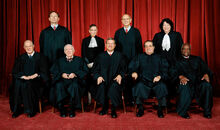No edit summary |
No edit summary |
||
| Line 27: | Line 27: | ||
=== 2014 Capitol Hill Occupation === |
=== 2014 Capitol Hill Occupation === |
||
After Senate Majority Leader Chuck Schumer lead the senate to pass a resolution which would've impeached President Baldwin, Baldwin used executive orders to re-occupy Capitol Hill using the military. Though the Senate's process was broken up, Chuck Schumer avoided arrest due to the unpopularity of such a move. |
After Senate Majority Leader Chuck Schumer lead the senate to pass a resolution which would've impeached President Baldwin, Baldwin used executive orders to re-occupy Capitol Hill using the military. Though the Senate's process was broken up, Chuck Schumer avoided arrest due to the unpopularity of such a move. |
||
| − | [[Category: |
+ | [[Category:Putin's Ambition]] |
Revision as of 21:46, 1 December 2019

The United States Supreme Court
Baldwin v United States was a supreme court case in which Congress sued the Baldwin administration for violating several aspects of the United States Constitution.
Background
Chuck Baldwin attempted to convince congress to declare war on the Russian Federation after the invasion of Georgia in 2008, but Congress voted nearly unanimously to not declare war. Baldwin would then sign an executive order to declare war on Russia and then would use his control over the military to relocate troops to Georgia. This provoked congressional, judiciary, and national backlash with Baldwin's approval rating falling to 9%
Previous attempts to sue Chuck Baldwin.
"This isn't an American Presidency, this is a fascist dictatorship." - Senator Joe Lieberman (on Baldwin's administration)
Congress and the Supreme Court attempted on several occasions to sue and impeach Chuck Baldwin. But every time it was attempted, Baldwin would use his control of the armed forced to occupy capitol hill and the supreme court building until the Supreme Court would be forced out of session or until Congress would temporarily disband for the rest of the week. It was reported that such incidents occurred over 5 times throughout Baldwin's presidency. It wasn't until the Russian repulsion of American armed forces from D.C. that allowed for the Supreme Court and congress to properly put Baldwin on trial.
The Case
The trial began 2 days after World War 3 on December 27th, 2015 and concluded in less than 1 day on December 28th, 2015. The Supreme Court voted unanimously that Baldwin was guilty, the case would then be brought to the international criminal court where Baldwin would arrested for several war crimes.
Evidence used against Baldwin during the trial
Throughout the trial, three major cases were brought up as reasoning for finding Baldwin guilty.
2010 Capitol Hill Occupation
While exploring impeachment process for Chuck Baldwin on August 8th, 2010; President Baldwin ordered the military to occupy capitol hill and break up the House investigation. Speaker Pelosi declared the act "blantantly authoritarian". This incident was brought up as one of the many times Baldwin acted in an unconstitutional way.
Arrest of Senator Joseph Lieberman (2012)

Senator Joseph Lieberman
After calling Baldwin's administration a "fascist dictatorship" on an interview with ABC news, Senator and former VP candidate Joseph Lieberman was arrested at his residential quarters in Washington D.C. for "spreading false information". Lieberman would remain in jail until the Russian occupation of Washington D.C. which ultimately freed him. He was one of the several people to testify during the court case.
2014 Capitol Hill Occupation
After Senate Majority Leader Chuck Schumer lead the senate to pass a resolution which would've impeached President Baldwin, Baldwin used executive orders to re-occupy Capitol Hill using the military. Though the Senate's process was broken up, Chuck Schumer avoided arrest due to the unpopularity of such a move.
